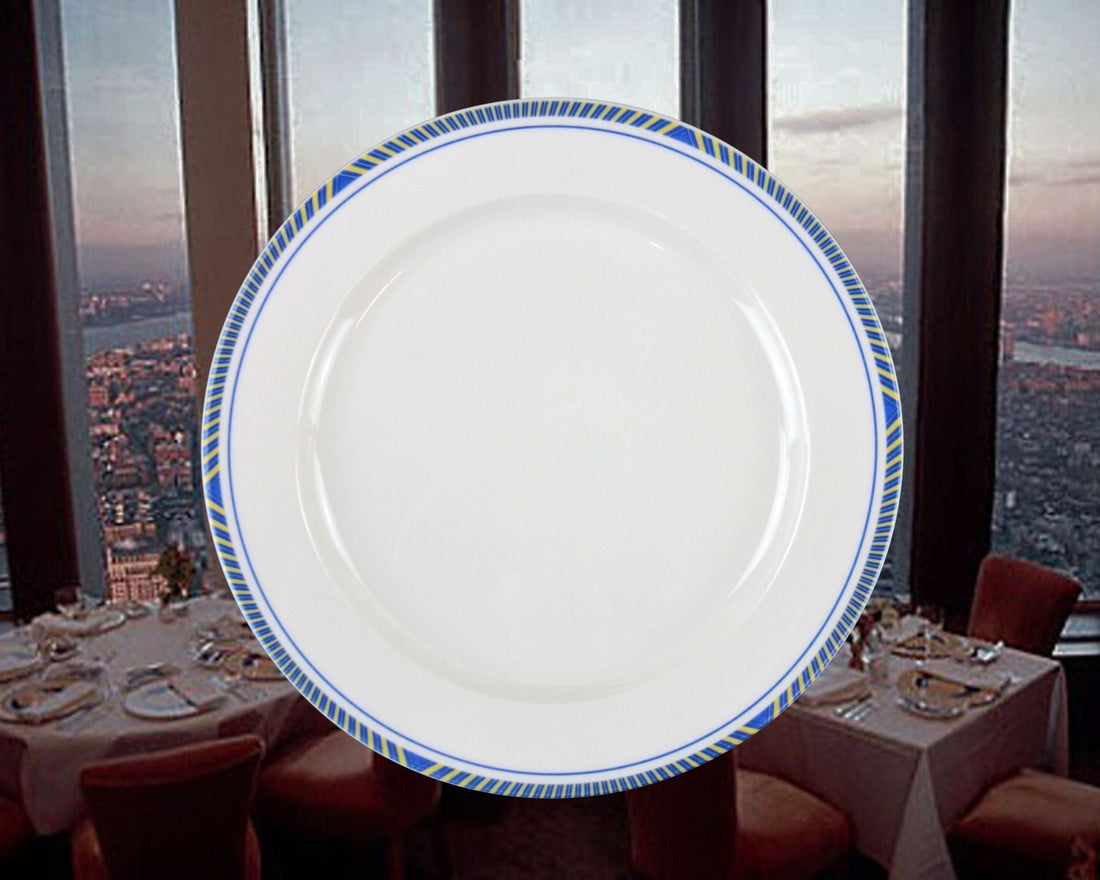
“Table for One, By The Window Please”: A Relic from the World Trade Center’s Lost Restaurant
Share

In early September 2001, just days before the world changed forever, Windows on the World — the iconic restaurant atop the North Tower of the World Trade Center — catered an elegant private dinner in a client’s New York home. It was the kind of bespoke service only a restaurant of that caliber could offer: not just delicious food, but the full dining experience, right down to the iconic signature porcelain dishware.
The staff arrived with everything needed — courses meticulously prepared, wine thoughtfully selected, and dishes packed carefully for the occasion. The porcelain plates they brought, rimmed in cobalt blue and golden yellow, came straight from the restaurant’s sky-high dining room. After the meal, the dishes were washed, stacked, and set aside to be returned the following morning.
That morning was September 11, 2001.

A Restaurant in the Clouds
When Windows on the World opened on April 19, 1976, it wasn't just another restaurant—it was a bold statement of New York's ambition and elegance. Situated on the 106th and 107th floors of the North Tower of the World Trade Center, it offered diners panoramic views that stretched beyond Manhattan to Brooklyn and New Jersey. The experience was akin to dining in the sky, with the city's vast expanse unfolding beneath
The visionary behind this establishment was restaurateur Joe Baum, renowned for creating iconic dining venues like The Four Seasons and La Fonda Del Sol. Baum, along with partners Michael Whitman and Dennis Sweeney, created 22 restaurants for the World Trade Center, many of which were casual operations located in the basement concourse. But the most elaborate Baum creation was Windows on the World, which occupied the 106th and 107th floors of the North Tower. Collaborating with architect Warren Platner, Baum designed a space that was both grand and modern. Graphic designer Milton Glaser, famed for the "I ♥ NY" logo, contributed to the restaurant's visual identity, crafting its logo, menu artwork, and distinctive dishware patterns. Culinary legends James Beard and Jacques Pépin lent their expertise to develop a menu that reflected an international crossroads of gastronomy, perfectly suited to the setting and the city.
Initially operating as a private club with 1,500 members, Windows on the World quickly became a coveted dining destination. The Cellar in the Sky, an offshoot, boasted an expansive wine list curated by young sommelier Kevin Zraly, paired with a five-course menu of American and European fare.

Critics and patrons alike were captivated. Gael Greene of New York Magazine described the experience: "Every view is brand-new—a miracle... Even New Jersey looks good from here." The restaurant's popularity soared, with a waiting list fully booked for six months within its first year
Despite facing challenges, including a temporary closure after the 1993 World Trade Center bombing, Windows on the World underwent a $30 million renovation and reopened in 1996. Under the culinary direction of Chef Michael Lomonaco, the restaurant embraced a modern American menu, emphasizing local ingredients and sustainable practices. By 2000, it had become the highest-grossing restaurant in the United States, generating $37.5 million in sales
Dining at Windows on the World was always a celebration, and a testament to New York City's spirit. The restaurant stood as a beacon of sophistication, offering an unparalleled experience that combined exceptional cuisine, design, and breathtaking views.

A New Era Under Chef Michael Lomonaco
After the World Trade Center bombing in 1993, Windows on the World was shuttered for renovation. When it reopened in 1996, it did so with a bold new vision, helmed by acclaimed chef Michael Lomonaco. A television personality and cookbook author, Lomonaco brought fresh energy to the menu, emphasizing American cuisine with global touches and seasonal ingredients.
He transformed the restaurant into a culinary destination once again. The wine program expanded. The Greatest Bar on Earth opened alongside it. The restaurant wasn’t just revived — it was elevated.
On the morning of September 11, 2001, Lomonaco was spared by fate. He was running late, delayed by a stop at the ground-level optical shop. Everyone upstairs, including his staff, did not escape.
The Dinner Before the Day
The dinner Windows on the World catered in the days before 9/11 was the kind of personalized experience it had become known for. The restaurant didn’t just prepare the meal — it brought the whole restaurant to the client’s home. That included the elegant Glaser-designed porcelain.
The evening went off without a hitch. Plates were wiped clean, stacked carefully, and set to be returned to the North Tower first thing in the morning.
The Attack and the Loss
At 8:46 a.m. on September 11, 2001, American Airlines Flight 11 crashed into the North Tower, impacting floors 93–99. Windows on the World, located above the impact zone, was instantly cut off from all means of evacuation. It’s estimated that 72 restaurant staff and 52 guests were trapped in the restaurant that morning. No one on those upper floors survived.
The restaurant — with its wine cellars, glassware, furnishings, and dishware — was obliterated in the collapse.

A Plate Becomes a Memorial
Among the few known pieces of Windows on the World dishware still in existence today is one of the plates used at that final private dinner. It was never returned, and in time, this example, found its way into the collection of Ronald Hoskins, an eclectic historian and collector. The plate, measuring 10.5 inches, bears the familiar Glaser design — the blue and gold rim clean and bold, the white center unblemished except for faint signs of use.
Very few examples of this porcelain survive. Some are housed in the Smithsonian’s September 11: Bearing Witness to History collection, and a handful can be seen in the 9/11 Memorial & Museum. Most were lost forever in the collapse of the towers. We are honored to be able to offer this plate to our clients.
More Than a Plate
This plate is now part of a memory of a restaurant, one of the most important to ever exist, that meant something deeply to its city, of people who took pride in what they created each day atop the world.
To see it now is to understand what was lost — not just in architecture or skyline, but in humanity, craft, and everyday beauty. It’s a quiet object with a loud echo: of lives lived, of service rendered, of a table once set high above Manhattan, ready for dinner.
“Table for one? By the window please?”
Do you have a relic or item from the World Trade Center that you would like to sell? Please contact our team!
